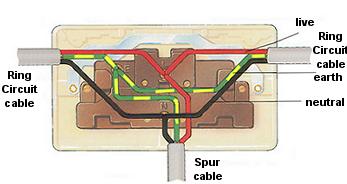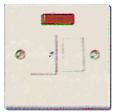Wiring for electric appliances in domestic premises
(See this page for the 2004 changes in cable colours)
ring circuit - fused outlets - high power - out of doors
Please note that all electrical wiring and installation details given on diydata.com is for information purposes only. From 1st January 2005, the Building Regulations Part P requires, in England and Wales, that only certified persons can carryout electrical installation work, or the work must be certified upon completion - see this page for more details.
Ring circuit
The ordinary wall sockets around the house are normally connected to a ring circuit (also referred to as a ring main). The ring circuits of a domestic property supply the socket outlets and fixed appliances in the premises.
The 'ring' is formed by the cable going from the consumer unit to the first socket, then on to the second socket and then the next socket etc. until the cable returns to the consumer unit. This means (in simple terms) that every socket on the ring circuit has two cable routes back to the supply. The cable of the ring circuit consists of a brown (live) wire, a blue (neutral) wire and a bare copper earth wire, all three being enclosed by an outer PVC sheathing. The cable used in domestic ring circuits is either 2.5sq mm or 4.0sq mm twin core and earth, these are rated (in free air) at 24amps or 32amps respectively.

Each ring circuit is protected by a 32 amp fuse or trip fitted in the consumer unit. Modern installations incorporate a Residual Current Device (RCD) before the consumer unit which trips the whole system off if a fault is detected.
In older houses the cabling for ring circuits (and other circuits) may be fed through the wall cavity with the cables coming into the back of the wall mounted socket. This is unacceptable in new premises and extensions. It is now considered that cables within the cavity may become wet causing the insulation of the cable to break down and moisture running down the cable into the socket. When rewiring older houses, new cables should not be run through the cavity, they should be run through new ducting embedded in the inner wall surfaces or under floorboards.
A ring circuit is considered to be rated at 30amps (7200 watts). A ring may serve up to 100 m sq of floor area and, in theory, may have any number of sockets outlets or fused connection units connected to it. With each socket outlet is normally rated at 13 amps, as a 'rule of thumb', they are limited to under twenty outlets, it is unlikely that the variety of domestic appliances being used at any one time will exceed 30amps. The length of cable used in a ring circuit is limited to 50 metres for circuits protected by an MCB. The sockets are normally mounted flush with the wall although surface mounted boxes are often easier to fit when sockets are added to the circuit.
High power electrical appliances (such as cookers, showers etc.) should not be connected to a ring main even if they use less current that the 30 amp rating of the ring circuit. Connection of such appliances will reduce the number of other appliances that can be use simultaneously and will lead to nuisance trips at the consumer unit.
It is advisable to have at least two ring circuit in all premises, in multi floor houses, one for each floor. The kitchen may have a large number of electrical appliances so a separate ring circuit for the kitchen may also worthwhile, this has the added benefit that a freezer will not be affected if there is a fault elsewhere. A single ring circuit should serve a floor area no greater than 100sq m (or 120sq yd).
In the UK, plugs used on a modern ring circuit have square pins and each plug is fitted with either 3 or 13 amp fuses. The correct fuse should always be fitted to suit the appliance, 3 amp fuses for appliances rated up to 750 watts, (lamps and clock radios etc.) - 13amp fuses for larger appliances up to 3000 watts.
Spur extensions can be connected to the ring circuit. A spur is a socket connected into the ring by a single cable run so the socket does not have the full benefit of two cable routes to the consumer unit. Spurs are often used when a socket is added, it is easier to connect using a single cable rather than extending the ring circuit to include the new socket. A spur extension can be connected to the ring circuit provided that it supplies only 13 amp socket outlet (although that can be a double socket outlet) or one fixed appliance. Over the whole ring, the total number of spurs must not exceed the number of socket outlets directly on the main ring. No more than two separate spurs may be connected from each outlet on the ring.
Removal of the front of a wall socket will give an indication of the circuit connected to it:

Note: this figure shows 'old' wiring colours - 'new' (post 2004) colours are: Brown = live, Blue = neutral, earth remains the same.
- A single cable connected to the terminals indicates that it is an existing spur.
- Two cables may indicate either that it is on a main ring circuit OR that it is a spur with another spur connected to it. This is not a recognised configuration but possible if both spur sockets are single sockets.
- Three or four cables normally indicate a socket on a main ring circuit with one or two spurs running from it.
If the wiring has been changed by a previous diy'er, it may be possible to identify any added cables and then deduce the original circuit.
Ring circuit fused outlet units
 Where connection to a fixed appliance is required, a fused outlet unit may be fitted to the wall (rather than a plug socket) and connected into the ring main. These outlets require the correct fuse rating for the appliance and are connected to the appliance by a cable or flex. The outlet may be switched or unswitched and may be fitted with an indicator light to show when the supply is connected.
Where connection to a fixed appliance is required, a fused outlet unit may be fitted to the wall (rather than a plug socket) and connected into the ring main. These outlets require the correct fuse rating for the appliance and are connected to the appliance by a cable or flex. The outlet may be switched or unswitched and may be fitted with an indicator light to show when the supply is connected.
Where a flex is taken to a heater of any sort (e.g. night store heater) the flex must be of a special 'high temperature' type suitable for the elevated temperatures encountered. Use of ordinary flex will result in the insulation breaking down causing the flex to become dangerous.
 A clock outlet is a similar type of unit, but with a small fuse fitted in a special plug connected to the flex. The plug may be retained in the socket by a screw or knurled thumbscrew. Though called a clock outlet, they are also suitable for other small low current appliances such as extractor fan units, door bells.
A clock outlet is a similar type of unit, but with a small fuse fitted in a special plug connected to the flex. The plug may be retained in the socket by a screw or knurled thumbscrew. Though called a clock outlet, they are also suitable for other small low current appliances such as extractor fan units, door bells.
High Power circuits.
 Within domestic premises, there may be a number of high wattage appliances, the most common being an electric cooker, immersion heater and electric shower. Each of these appliances should be connected to the consumer unit using a dedicated fuse/trip and cable run. The installation instructions for the appliance should detail the wattage of the appliance (which will also normally be shown somewhere on the appliance), the amperage of the fuse/trip and the size of cable required. Any switches on these circuits must also be of a suitable current rating.
Within domestic premises, there may be a number of high wattage appliances, the most common being an electric cooker, immersion heater and electric shower. Each of these appliances should be connected to the consumer unit using a dedicated fuse/trip and cable run. The installation instructions for the appliance should detail the wattage of the appliance (which will also normally be shown somewhere on the appliance), the amperage of the fuse/trip and the size of cable required. Any switches on these circuits must also be of a suitable current rating.
Power for out of doors.
When power is required for the shed, patio, garden pond or other out of doors purpose, a separate circuit from the consumer unit should be used. Where a Residual Current Device (RCD) is not already fitted before the consumer unit, one should be installed. The Residual Current Device will switch off the electricity almost instantaneously if a fault develops in the circuit.
Waterproof sockets must be used where an outside socket is required, an internal control switch is also recommended so that the outside socket can be isolated if necessary.
There are a number of alternatives to using mains electricity in the garden, low voltage garden lights and appliances are available to reduce the risk of using electricity out of doors.
